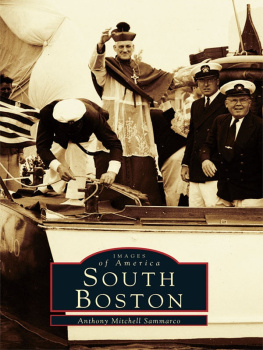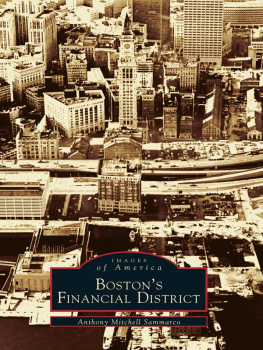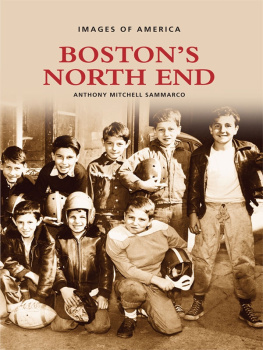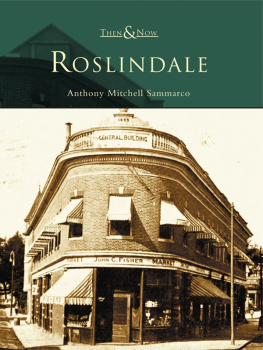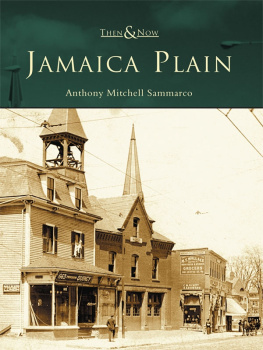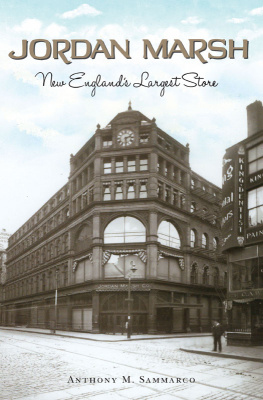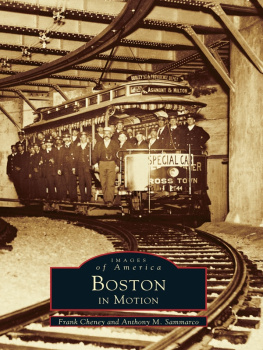

A white-dressed server scoops ice cream from the freezer with his left hand, with four waffle cones nestled in his right hand. As the wall sign reads, these are Howard Johnsons Famous 28 Flavors, which are listed alphabetically. Although these premium ice cream flavors sometimes changed regionally, it was said that vanilla was by far the most popular choice.

Published by American Palate
A Division of The History Press
Charleston, SC 29403
www.historypress.net
Copyright 2013 by Anthony Mitchell Sammarco
All rights reserved
All photographs, unless otherwise noted, are from the Sammarco Collection, Archives and Special Collections, Joseph P. Healey Library, University of MassachusettsBoston.
First published 2013
e-book edition 2013
Manufactured in the United States
ISBN 978.1.61423.916.1
Library of Congress Cataloging-in-Publication Data
Sammarco, Anthony Mitchell.
A history of Howard Johnsons : how a Massachusetts soda fountain became an American icon / Anthony Mitchell Sammarco.
pages cm
Includes bibliographical references.
print edition ISBN 978-1-60949-428-5 (paperback)
1. Howard Johnson (Firm)--History. 2. Johnson, Howard Deering, 1897-1972. 3. Restaurants--United States--History. 4. Restaurants--East (U.S.)--History. 5. Motels--United States--History. 6. Motels--East (U.S.)--History. I. Title.
TX945.5.H595S25 2013
647.9573--dc23
2013029385
Notice: The information in this book is true and complete to the best of our knowledge. It is offered without guarantee on the part of the author or The History Press. The author and The History Press disclaim all liability in connection with the use of this book.
All rights reserved. No part of this book may be reproduced or transmitted in any form whatsoever without prior written permission from the publisher except in the case of brief quotations embodied in critical articles and reviews.
For Cesidio Joe Cedrone
Nunquam non paratus (Never unprepared)
Clan Johnstone
Contents
Acknowledgements
Theres many a king on a gilded throne
But theres only one king on an ice-cream cone.
So we crown him today with friendly acclaim,
All over the country well blazen his name.
With hot dogs barking in approbation,
Hes the man who believes he can feed the nation.
Howard Johnsons, 1940
I would like to extend my sincere thanks and deep appreciation to the following friends, acquaintances and kind interested people who offered assistance, shared their reminiscences of Howard Johnsons or loaned photographs:
The late John Eagles Alcott; Kai Bridge Armstrong; Leslie Rappaport-Atlas; Steve and Christine Alcott Baptiste, for loaning family photographs; Harris Beals; Boston Public Library, Henry Scannell; the women at the Brighton Tops; Ronald J. Brodeur; Sue Anne Brogan; Jennifer Brooks; Helen Graham Buchanan; John Burrows; Robert Burrows; Carol Campanelli; Jamie Carter; Cesidio Joe Cedrone; Elise Ciregna and Stephen Lo Piccolo; Edie Clifford; Regina K. Clifton; Katherine Coleman; Colortek of Boston, Jackie Anderson and Girolamo Grassa; Matthew Hallowell Crocker; Elizabeth Curtiss and Lynne Matthews; Patricia Desmond, publisher of the Milton Times; Paul J. Durgin, for the loan of annual reports and Durgin family papers; Olivia Grant Dybing; eBay; Larry and Betsy Edsall; Frances Pierce Field; Dale H. Freeman, digital resource archivist, University of Massachusetts; Jean Goldman and Vincent Da Forno; Edward W. Gordon; Gretchen Grozier; Daniel Haacker, assistant director, Milton Public Library; Joan Halpert and Peter Hanson; Ronald and Donna Lee Hanlon; Helen Hannon, with thanks for her assistance in research on the Johnson family; Dorothy Verne Johnson Weeks Henry; Historic New England, Lorna Condon; Jon Robert Hogan and Gaveston Nguyen; Muriel Cicco Holmes; Hutchinson; Barbara Kerr; Stephen Kharfen; the late Kathleen Kingston Lawlor; Paul Leo; Michael Lonardelli; Chris Lovett; Caroline Stewart Macon; Brenda Murphy Madden; Reverend Karen Maleri; Martin Manning; Massachusetts Historical Society, Andrea Cronin; Dr. John McConville; David McGinness; Milton Cemetery, Therese Desmond, superintendent; Town of Milton, Mary Fitzgerald and Rena McDermott; Elizabeth Mock; Hilda M. Morrill; Allan R. Morris; Mount Wollaston Cemetery in Quincy, Massachusetts, Jeanne Flaherty; Eddie Mulkern; Fran Murphy; New England Historic and Genealogical Society, Alice Kane, for her genealogy on the Johnson and Wright families; Bruce Nord; Frank Norton; Orleans Historical Society, Tamsen George; James Pardy; Pasqualina; Mary E. Paul; William H. Pear II; Scott Piatov; Steve and Linda Mason Pirie; Harold Irving Pratt Jr.; Providence Public Library; the Quincy Historical Society, Dr. Edward Fitzgerald, director, as well as Corinne Waite and Robert Bloomberg; the Quincy Public Schools, Mary McDonald; Lilian M.C. Randall; Kita and Chris Reece; Louise Richardson; Joanne Riley, University of Massachusetts, archivist; Patricia Rissmeyer; Matt Rocheleau, Boston.com; Charlie Rosenberg and Fran Perkins; Jeffrey Saraceno, my ever patient commissioning editor; Carolyn S. Savage; Andy Sawicky; Schlesinger Library, Radcliffe Institute, Harvard University, Diana Carey; Bonnie Snow; Snow Library, Orleans, Tavi Prugno; Peter Soffron, for loaning family photographs; Steve Soffron; Ernest C. Sofis; Kelly Spalding; Jean Sprague Stewart; Jeanne and Bill Sutton; Robin Tetley; Thomas Crane Public Library, Megan Allen, director, and Linda Beeler, head of reference; Jean and Joseph Troccoli; Ken Turino and Chris Mathias; University of Massachusetts, Archives and Special Collections, Joseph P. Healey Library, Boston, Joanne Riley; the Urban College of Boston, Michael Taylor, president; the Victorian Society, New England Chapter; Steven Walker, South End Photo Lab; Ann and Tom Walsh; WBZ Radio 1030, Jennifer Brien; Richard E. Weber, the Sprague Project; Ellen and Tom White; Wikipedia; Jennifer Morgan Williams; James Preston Wysong; Andrea Young and George A. Soffron; Jack and Marie Zinkus.

The first sketch for the proposed logo of Howard Johnsons company was drawn by John Eagles Alcott (18991978) in 1935: Simple Simon and the Pieman at the Fair, complete with a drooling dog, with pencil notes on colors, design and details. As the brand that was to be used on advertising, dinnerware, swizzle sticks, napkins and roadside marquees that stood in front of the restaurants. Courtesy of Steve and Christine Alcott Baptiste.
Introduction
The consumption of ice cream among Yankees varies inversely with the velocity of the east wind.
Fortune magazine, September 1940
Howard Johnson created an orange-roofed empire of ice cream stands and restaurants that, following World War II, stretched from Maine to Florida and from the East Coast to the West Coast. Popularly known as the Father of the Franchise Industry, he revolutionized the restaurant industry in the United States and thereby ensured the continual existence of delicious foods and quality prices that brought appreciative customers back for more.
Next page


